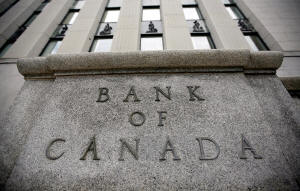Weaker loonie may not deter Bank of Canada diverging from the Fed
 Send a link to a friend
Send a link to a friend
 [May 18, 2024] By
Fergal Smith [May 18, 2024] By
Fergal Smith
TORONTO (Reuters) - The Bank of Canada would be willing to cut interest
rates three times ahead of the Federal Reserve's first move before a
declining currency threatens to endanger the inflation outlook, the
median estimate of seven analysts in a straw poll showed.
A weaker Canadian dollar versus the greenback this year has sparked
debate among investors about how much the BoC would be prepared to
diverge from its U.S. counterpart.
Investors expect the Canadian central bank to begin rate cuts in June or
July, with next Tuesday's inflation reading seen as a key input. But the
Fed is seen on hold until September, even after cooler-than-expected
U.S. inflation data on Wednesday.
The BoC's benchmark interest rate, at 5%, already sits 38 basis points
below the midpoint of the range set by the Fed for its policy rate.
Further widening in the differential could add to pressure on the loonie.
Still, analysts say it would take a large move in the currency to drive
up import costs enough to put at risk the central bank's efforts to
lower inflation to a 2% target.
A higher cost of imported goods tends to raise the prices that
businesses charge to consumers.
"Although there's a theoretical limit to how far the Bank of Canada can
set its own policy rate beneath the Fed funds rate, it's likely well
below current levels," said Karl Schamotta, chief market strategist at
Corpay.

"The exchange rate could weaken if interest differentials were to widen
further ... but the passthrough to inflation should be relatively
modest."
The latest data shows inflation at an annual rate of 2.9% in March, down
from an 8.1% peak in June 2022. A Reuters poll of analysts predict
year-on-year consumer price inflation to be at 2.8% for April. The data
will be released by Statistics Canada on May 21.

[to top of second column] |

The Bank of Canada building is pictured in Ottawa June 1, 2010.
REUTERS/Chris Wattie/File Photo

The Canadian dollar has already weakened nearly 2.7% against its
U.S. counterpart since the start of the year, to 1.3602 per U.S.
dollar, or 73.52 U.S. cents, as the greenback climbed against a
basket of major currencies.
"As a rule of thumb, a 10% fall in the loonie would boost core goods
prices by 2.5%," Olivia Cross, North America economist at Capital
Economics, said in a note, adding that core goods make up about 30%
of the Canadian CPI basket.
There is a limit to how far U.S. and Canadian interest rates can
diverge, but "certainly we're not close to that limit," Bank of
Canada Governor Tiff Macklem said earlier this month.
The Canadian economy has lagged the U.S. economy in recent quarters,
weighed by weaker productivity growth as well as higher levels of
household debt and a shorter mortgage cycle, a factor some
economists argue should see the BoC move ahead of the Fed.
The OECD projects Canada's economy will grow 1% this year, much less
than the 2.6% rate it forecasts for the United States.
The interest rate gap has stayed within 100 basis points since the
global financial crisis of 2008-09. Still, that level may not be a
binding constraint if the Canadian outlook deteriorates over the
second half of 2024, said Robert Both, a senior macro strategist at
TD Securities.
"A larger-than-expected drag on the household sector from mortgage
renewals could give the Bank more license to diverge from the Fed,"
Both said.
(Reporting by Fergal Smith; Editing by Leslie Adler and Andrea
Ricci)
[© 2024 Thomson Reuters. All rights
reserved.]
This material may not be published,
broadcast, rewritten or redistributed.
Thompson Reuters is solely responsible for this content. |